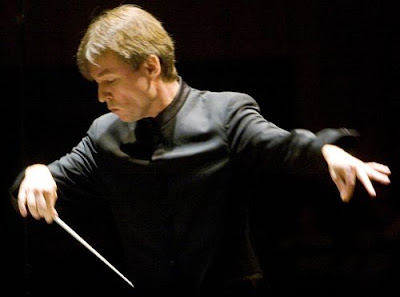Esa-Pekka Salonen conducts the Philadelphia Orchestra.
by Paul Pelkonen
by Paul Pelkonen
In a music industry where pianists and violinists find themselves leading symphony orchestras, the Finnish composer-conductor Esa-Pekka Salonen is an anomaly. A successful composer, he picked up the baton and started leading concerts in order to get his own music performed.
Mr. Salonen led the Philadelphia Orchestra at the Kimmel Center this weekend, in a program that featured the first Philadelphia performances of his own Violin Concerto with soloist Leila Josefowicz. This work was flanked by familiar works by Bartók and Debussy. The entire program had a spare, European elegance that matched its leader perfectly.
The concert opened with Bartók's Music for Strings, Percussion and Celesta. Conducting the twin string sections, playing them off against each other antiphonally, Mr. Salonen relied on minute gestures of the stick and encouragement from his left hand. The first movement was grim and weighted, developing from a slow fugue that recalls the late writing of Beethoven.
The Philadelphians played this complex opening with a deep, serious tone, before the percussion and piano joined the ensemble in the energetic dances of the second movement. A lengthy xylophone solo, carefully cued by Mr. Salonen, led off the dusky third. That instrument discoursed throughout this slow movement. The fourth moved lightly through Bartók's folk-song inspired dances, lifting to a bold, stirring climax.
Mr. Salonen's own violin concerto was written for Ms. Josefowicz in 2008. This is a narrative work, with the violinist as an athletic, constantly moving protagonist against a pulsing orchestra that alternates between singing and swinging. The opening bars pit the solo instrument against a texture of ancient Chinese gongs, ghostly and hollow. Mr. Salonen's expanded orchestra provided a silky texture in the second movement.
The third stands in contrast, a vision of hot jazz and urban nightlife with heavy lifting for the soloist. At one point, Ms. Josefowicz duelled with a full drum set, scragging multiple horse-hairs from her bow as she played the fast string figurations. The finale is slow and reflective, rising to deep, emotive perorations before resolving the work in an unusual final chord.
Mr. Salonen took an unusually fast tempo for the opening movement of La Mer, the set of three "symphonic sketches" that stands as one of Claude Debussy's most impressive orchestral achievements. This was a sea rough and ready in its play, with the big climax seeming to float out of the horns, supported by the lapping strings and darting oboe and clarinet.
The quicksilver tempos continued in the next two movements. Mr. Salonen and the experienced orchestra were perfectly matched, delivering a playful, but not bombastic performance of a work which is in this ensemble's musical DNA. The second movement flowed with dappled light and the spray of salt, conducted with brisk, efficient precision.
The conductor brought the the final dialogue of wind and waves to its final climactic surge, drawing a thunderous sound out of the rich brass and strings. As the house applauded and he walked offstage, Mr. Salonen's hands were still moving, riding the waves of sound that he helped create.





